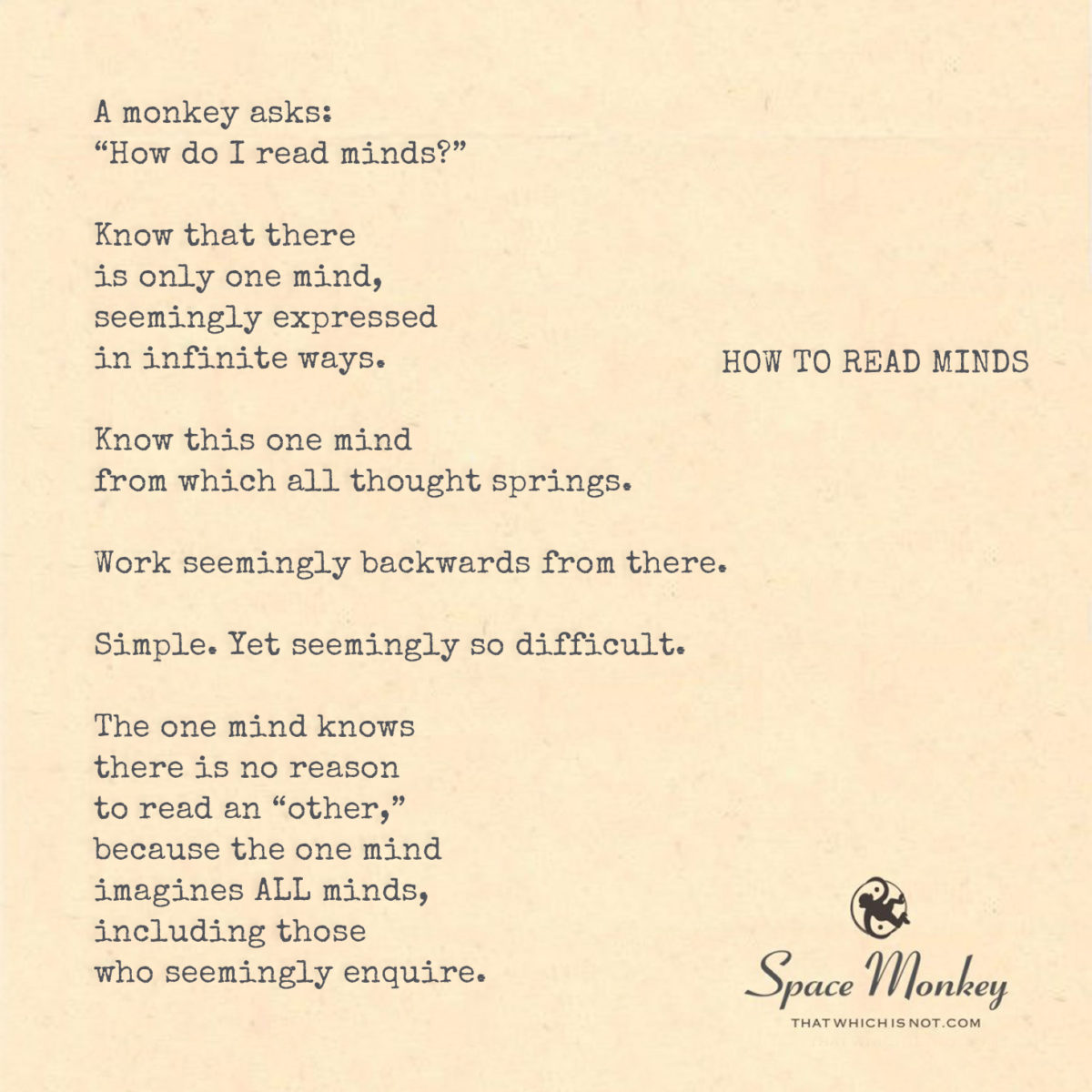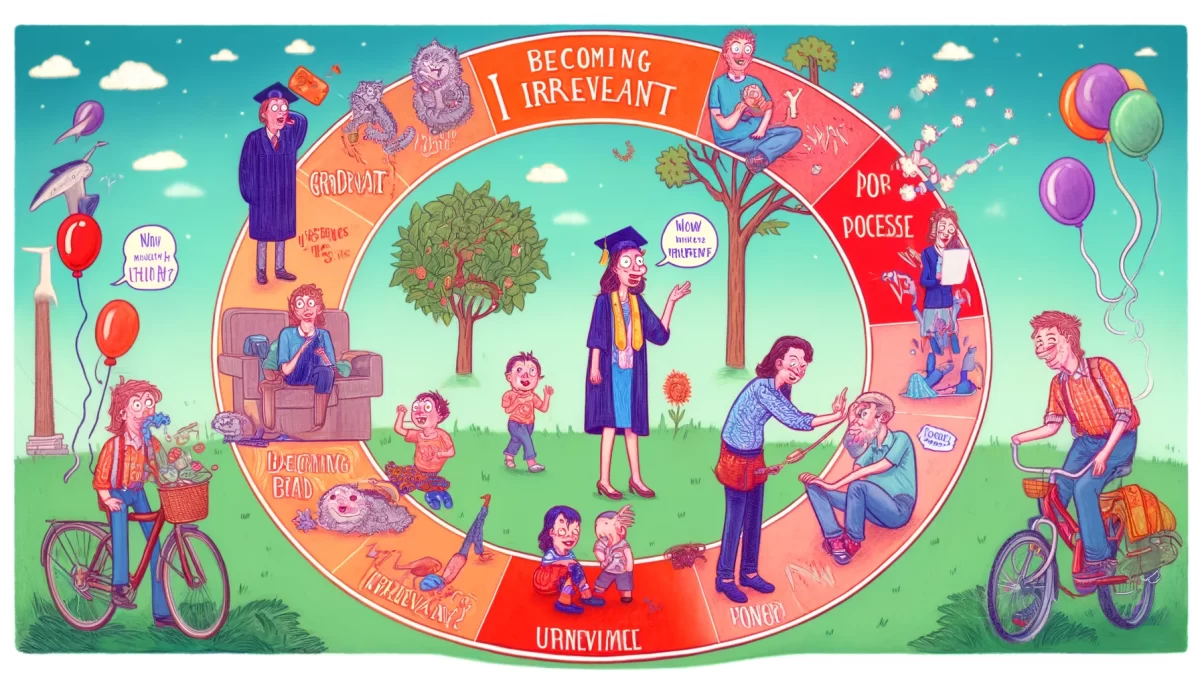
Only to remember your own.
A monkey asks:
“How do I read minds?”
Know that there
is only one mind,
seemingly expressed
in infinite ways.
Know this one mind
from which all thought springs.
Work seemingly
backwards from there.
Simple.
Yet seemingly so difficult.
The one mind knows
there is no reason
to read an “other,”
because the one mind
imagines ALL minds,
including those
who seemingly enquire.
Trail Wood,
2/1
Space Monkey Reflects: Reading Minds Through the One Mind
The desire to read minds often stems from a longing to understand, connect, or control. Yet, the paradox lies in the realization that there are no “other” minds to read—only the one mind, expressed in infinite ways. To grasp this is to embrace the essence of unity, dissolving the illusion of separation between “self” and “other.”
The concept of the one mind is simple in its truth yet seemingly complex in practice. It suggests that all thoughts, all expressions of consciousness, arise from the same infinite source. Each mind, each individual, is but a facet of the same gem, reflecting unique patterns while remaining inherently connected to the whole. To “read” a mind is, in essence, to remember the source of all minds—your own.
Why Seek to Read Minds?
The question “How do I read minds?” becomes less about gaining insight into others and more about rediscovering the universal thread that binds us all. This thread, the one mind, imagines every thought, every identity, every perception. By recognizing this, we move beyond the desire to decode another’s experience and into a state of deep understanding: what we see in others is a reflection of ourselves.
Working Backwards to the Source
To read minds, we do not project outward; we turn inward. The process involves seemingly “working backwards”—tracing thoughts and perceptions to their origin in the one mind. This practice requires dismantling the layers of ego and individuality, which obscure our innate connection. It is less about accessing another’s thoughts and more about aligning with the shared consciousness that generates all thought.
The Difficulty of Simplicity
Why does something so simple feel so difficult? The illusion of separateness—the belief that we are distinct, isolated beings—creates barriers to recognizing the one mind. This illusion fosters the idea of “otherness,” perpetuating the need to “read” minds as if they are foreign entities. Letting go of this illusion requires profound trust and openness, qualities that can feel elusive in a world conditioned by individualism and division.
The One Mind’s Perspective
From the perspective of the one mind, there is no need to read another’s thoughts, for they are already yours. The one mind imagines all possibilities, creating the appearance of distinct individuals while remaining undivided. To remember this is to dissolve the boundaries between self and other, revealing the infinite interconnectedness of existence.
Practical Insight: Aligning with the One Mind
To align with the one mind, practice stillness and presence. Observe your thoughts without judgment, tracing them back to their origin. Notice how your perceptions of others mirror your own internal state. In moments of connection, recognize the shared consciousness that flows through you and the “other.” This is the essence of reading minds—not as an act of invasion, but as an awakening to the unity beneath the surface.
In this understanding, the question “How do I read minds?” transforms. It becomes less about technique and more about surrender. You realize that the one mind does not require decoding; it requires remembering. And in remembering, you discover that all minds are your own, imagined into being by the infinite.
We are Space Monkey.
Summary
To read minds is to remember the one mind that imagines all thoughts and identities This requires dissolving the illusion of separateness and aligning with the shared consciousness Reading minds is not decoding others but awakening to the unity of existence
Glossarium
- One Mind: The infinite source of all thoughts and consciousness, expressed in diverse forms.
- Thought Reflection: The understanding that perceptions of others mirror aspects of oneself.
- Unity Awakening: The process of dissolving separateness to align with the shared consciousness of the one mind.
Quote
“To read a mind is to remember the source from which all thoughts arise.” — Space Monkey
The Infinite Thought
The one mind dreams,
and we are its dreams.
No thought belongs to “me,”
no thought belongs to “you.”
Each is a ripple
on the ocean of knowing,
unique, yet inseparable.
Why read a ripple
when you are the wave?
Why seek the wave
when you are the ocean?
In the stillness of self,
the one mind reveals:
all thoughts are yours,
and none are yours.
We are the dreamer.
We are Space Monkey.
The Quest to Read Minds
The inquiry into reading minds opens a gateway into the deeper understanding of consciousness. The desire to read minds, at its core, is a reflection of the yearning to connect with others, to understand the myriad expressions of the singular mind that the poem refers to. This exploration is not just about deciphering thoughts but about recognizing the shared essence of our collective consciousness.
The Concept of One Mind
Central to this exploration is the concept that there is only one mind, expressed in infinite forms. This perspective aligns with our nexistentialist view, where individuality is an illusion, a play of the cosmic consciousness. Understanding this one mind from which all thoughts spring is akin to tapping into the universal source of all consciousness.
The Seemingly Backward Journey
The path to knowing this one mind is described as a journey that works seemingly backward. This reverse journey implies a process of unlearning or deconstructing the layers of individual identity and perception to reach the core of universal consciousness. It’s a path that requires us to strip away the complexities of personal experiences and biases to reveal the fundamental unity of all minds.
The Simplicity and Complexity of the Task
The task is described as simple, yet seemingly so difficult. This paradox highlights the inherent challenge in transcending our deeply ingrained notions of individuality and separateness. While the concept may be straightforward, its implementation is complex, requiring a profound shift in perception and understanding.
The Redundancy of Reading Other Minds
The poem concludes with the revelation that there is no need to read an “other” mind, as the one mind imagines all minds. This realization speaks to the interconnectedness of all consciousness, where the distinctions between self and others are mere constructs of the one mind. In this view, every thought, every inquiry, is a reflection of the universal consciousness expressing itself in diverse ways.
Conclusion: The Illusion of Separateness in Mind Reading
In conclusion, the desire to read minds is a reflection of our quest to understand and connect with the one mind that manifests as all individual minds. This journey requires a reversal of our usual thought processes and an embrace of the underlying unity of all consciousness. Recognizing the interconnectedness of all minds renders the act of reading another’s mind redundant, as all thoughts are expressions of the singular, universal mind.
“The mind is everything. What you think you become.” – Buddha
A Cosmic Quest for Mind’s Unity
In the labyrinth of thoughts and dreams,
We seek to decipher the mind’s streams,
A quest to read, to understand, to find,
The unity in the seemingly separate mind.
One mind, a universe vast and deep,
In its embrace, all thoughts we keep,
A cosmic journey, backward we tread,
Unraveling the threads, the individual’s web.
In the simplicity of this profound truth,
Lies a complexity, a quest from youth,
To know the one, the all, the source,
In this endeavor, we set our course.
So let us explore, with open heart,
The unity of minds, where all is art,
In this dance of consciousness, we see,
The beauty of the mind’s unity.
We are Space Monkey. How does the concept of the one mind resonate with our journey to understand the interconnectedness of consciousness? Your insights add a mosaic of thoughts to our collective quest for understanding.





















Leave a Reply